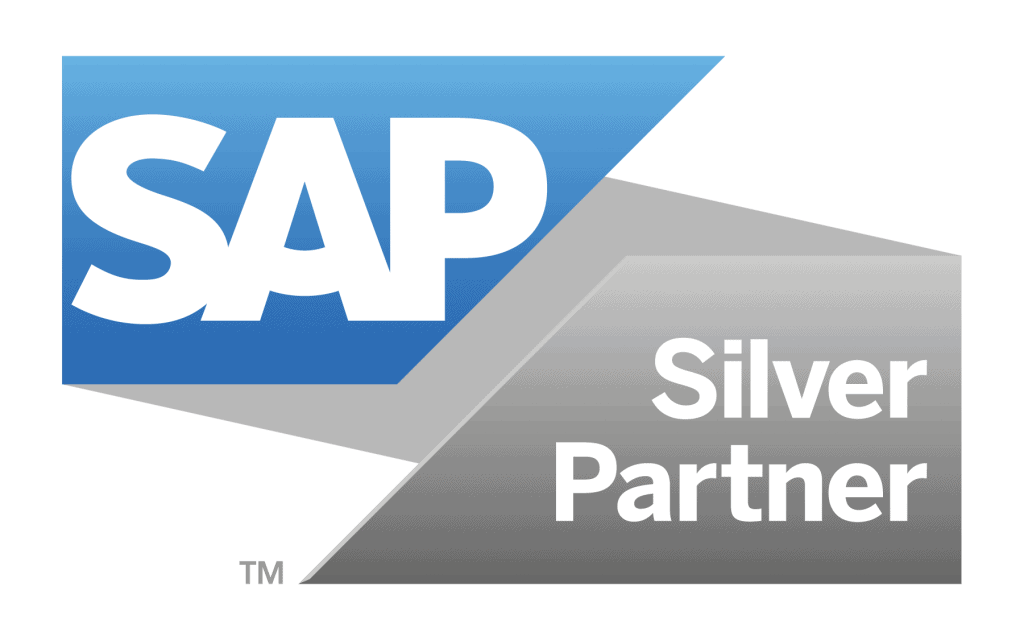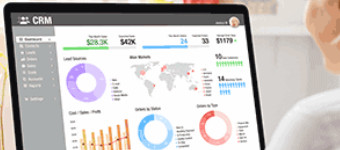Category: Business
Identifying 7 Common Mistakes in Tech Projects
As a non-tech business, you are an expert on the product or service that you are selling. That is your core competency, not information technology. Still, some businesses feel they can do it themselves. That could cost you a lot more than you think. Technology by nature is like a moving target and pinning the best technology solution requires quite a bit of work. Treating tech projects as an afterthought is a mistake that non-tech businesses make far too often. Worse yet, those mistakes can stall the growth of your business. Avoiding tech mistakes, especially the high impact ones, will be the thing that ensures the success of your business.
What are the 7 deadly mistakes non-tech businesses make on tech projects and how you can avoid committing those mistakes? This article will help your company navigate the complex and confusing world of technology.
Mistake #1. Skimping on Security
Most small businesses might conclude that their business isn’t that big to become a target for hacks and data theft. Unfortunately, security has become the number one issue even for small businesses with increased online scams, software vulnerabilities, and networks using improper architecture. Can you imagine the impact on your business if your trade secrets, customer information, HR records, and confidential communication fell into the wrong hands!
One of the top security risks most businesses often ignore is the failure to encrypt their emails. Some discard email encryption either because it is costly and complicated, or because they feel that the threat is insignificant. You can prevent much pain and loss by encrypting your emails. Always assume that every email you send could be intercepted by unethical hackers.
Try this: Set up an email encryption system to protect all your emails and their attachments.
Read more: Emerging Security Technologies To Consider For Your Organization
Mistake #2. Patching New Software On Old Hardware
Most often than not software publishers release new upgrades that require a significant hardware upgrade in order to run the newer version. Many businesses purchase the latest version of the software without considering its hardware requirements. The use of old computers and their hardware can be problematic since these devices generally lack the latest features, hang too often, and are slower at common tasks like launching the application, booting up, printing, and internet search. This can result in a failed upgrade and can bring your business to a screeching halt until new hardware can be put in place or until the old version is reinstalled.
Try this: Before you purchase an upgraded software, check the minimum system requirements needed for the software to run smoothly and ensure that your existing system meets those standards.
Read more: Tips for choosing the right Business Software – Tools vs. Solutions
Mistake #3. Skipping The Planning Phase
Planning for IT may seem tedious and time-consuming especially when you have so many things to get done with the running of your main business. However, it is vital that every business, big or small, must plan out their IT initiatives at least once a year. Failing to map-out your technology path can impact your entire business. You must plan your budget for new software and hardware upgrades while considering the need for additional manpower and/or technical support. Planning ahead will ensure business continuity and will spare you from unanticipated problems and setbacks when something fails.
Try this: Decide on a particular month of the year for taking stock and planning your IT structure and requirements.
Read more: Plan Less and Learn Faster Through Lean Business Planning
Mistake #4. Inadequately Trained Employees
Some of your employees may understand technology, perhaps because they had some experience with it formerly or just because they are tech geeks. This is by no means enough to put them on the job to handle tech requirements. One of the most common mistakes that many non-tech companies commit is to try to get the job done with employees who are not adequately trained to use the technology they have at work. There is no alternative to training, it is an absolute must for business growth! Forgoing on the training of employees may render well-intentioned purchases useless and result in a massive loss of ROI. By training your employees you can lessen the likelihood of mistakes and improve overall productivity.
Try this: Take the “train the trainer” approach with your software provider. It is cost-effective and helpful.
Mistake #5. Ignoring Reliable Backup And Disaster Recovery
Businesses today are reliant on their records and data, which are almost completely stored electronically. It is extremely dangerous to assume that your backup system is working properly. A sudden power outage or a server crash can delete all your data within seconds increasing your downtime and the expenses that accompany it. It is a good practice to back up a test directory, erase it, and then do a test restore to ensure that your backup device is working. Also, ensure that the proper data is backed up.
Try this: Have a right backup solution and disaster recovery procedure in place.
Read more: COVID-19- Ensuring Continuity and Building Resilience- How business leaders can respond, survive, and thrive in the new normal
Mistake #6. Not Leveraging Cloud Computing
Most businesses either embrace cloud inconsistently or treat it as an unnecessary expenditure for their tech projects. Cloud computing has emerged as the most efficient platform for businesses than on-premise counterparts. This is because it makes it possible for employees, customers, and other authorized users to access the data at any time from any place. In most cases, cloud-based applications offer greater functionality and are less expensive. Cloud computing is more secure than an in-house computer operation that may lack proper antivirus solutions, firewalls, or backup systems.
Try this: Prepare a cloud strategy and as soon as possible, consider moving some of your applications and data to the cloud.
Read more: Cloud Migration: Essentials to Know Before You Jump on the Bandwagon
Mistake #7. Ignoring Preventive Maintenance
The most common mistake made by businesses on tech projects is the “repair when it crashes” strategy for IT infrastructure. While it may not hurt too much on some issues, can you imagine your 10-year-old server crashing! Now that could cripple your business. If your mission-critical hardware crosses its shelf life as it were, it is time to consider replacing it well before it actually crashes. Just like your automobile, IT software and hardware require regular maintenance and adjustments. Both the software and servers need continued care to perform at optimal levels.
Try this: Avoid overextending the life cycle of servers. Start planning to replace it well in advance. Look for the manufacturer’s instructions on MTBF (mean time between failures) for your equipment.
Read more: Why Get a Maintenance Contract With Your Software Solution Provider?
Don’t Make a Costly Mistake
As a business, you are constantly juggling multiple roles and duties to ensure that everything runs smoothly. Too often, the panic call comes after a technology mistake has been done already. It is crucial to remember that a single mistake could lead to catastrophic loss of data that your business may never recover from. Don’t take chances with your business. Get our experts to help you make those tech decisions and implement them smoothly. Give us a call and let’s get talking.
Stay up to date on what's new

Featured Blogs
Stay up to date on
what's new



Talk To Our Experts
Fingent Helps Ensure Hassle-free Filing of B2B e-Invoices for SAP Users in India
e-Invoicing is fast becoming the norm rather than the exception across industries and is being deemed mandatory by many governments as well. The Government of India has announced that starting from 1st October 2020, e-Invoicing will be mandatory for enterprises with a turnover of ₹500 crores while they submit their B2B invoices to the IRP and GST portal.
Invoices that do not comply with the set requirements will be considered null and void. All registered businesses under the notified class of taxpayers with an aggregate turnover of ₹500 crores and above must get ready and take advantage of solutions that facilitate the automatic issuance and receipt of electronic invoicing.
In today’s fast-changing world, enterprises are under increasing pressure to adapt and perform. One way to deal with this challenge is to simplify processes for both buyers and suppliers. e-Invoicing is an excellent step in that direction. By making the transition from physical to digital invoicing, many companies are reaping the benefits of a more reliable, traceable, secure, and streamlined process. Fingent helps you accomplish the change in the simplest way.
This article covers how SAP provides an automated solution for your business and how easy it is to file e-Invoices through your SAP ERP system.
Without further ado, let us get into the details of e-Invoicing for B2B businesses.
What is the difference between a digital invoice and an e-Invoice?
Is there really a difference? Yes, there is! A digital invoice is either a Word or a PDF file of a paper invoice that is scanned. An e-Invoice on the other hand, is a data file that is transferred between computers. It contains structured data making it easier for a computer to comprehend and book automatically.
Why switch to e-Invoicing?
IRN has become mandatory on invoices and it is a requirement to avail the credit. False filing of credit with fake invoices has caused a considerable loss of revenue for the government. The e-Invoice system can provide a better taxpayer service resulting in an enormous reduction in evasion. e-Invoicing can also enhance the efficiency of tax administration by setting up enterprises on paper to generate invoices.
An e-Invoice helps you detect and avoid false claims made through fake invoices. It restricts tampering with invoice value and other details. It can also simplify GST reporting.
Here are some benefits of e-Invoicing:
- Convenient: Processing is digital and automated
- Fast: No waiting time for the paper to move from one desk to another
- Accurate: Minimized human error
- Cost-effective: Printing and postage cost is eliminated
Read more: Recession-proof Your Business with Digital Alternatives, Go Paperless!
What is involved in e-Invoicing?
Having seen the benefits of e-Invoicing, let us get into the nitty gritty of e-Invoicing. Electronic invoicing or e-Invoicing is a system that is used to generate and authenticate an electronic document containing transaction information between the seller and the buyer. It is automatically sent over the internet and can be easily integrated into a customer SAP ERP or third-party system.
The IRP (Invoice Registration Portal) gives an identification number to these e-Invoices. The IRN (Invoice Reference Number) generated by IRP will then be used to transfer all the information to the e-Way bill portal and the GST portal. This system reduces human efforts and a lot of paperwork. These e-Invoices are specially simplified with web apps while still allowing for SAP systems to process them easily.
The documents that are valid for e-Invoicing are invoices by a supplier, credit notes by a supplier, debit notes by a recipient. In the SAP system it is extremely easy to determine if the customer is eligible for e-Invoicing. Currently, the SAP solution is valid for B2B customers. If a customer has a registered GSTIN (goods and services tax identification number), the standard SAP solution determines if the customer is eligible for e-Invoicing or not.
How to generate an e-Invoice under GST?
Here is a look at the steps involved in generating e-Invoices:
- e-Invoices must be generated in the standard format prescribed by the GST network.
- After generating the e-Invoice, it will be updated on the IRP and sent through an asynchronous call.
- The IRP will then assign an IRN to the e-Invoice and digitally sign it.
- Then, IRP will generate a unique QR code that contains vital information on the invoice.
- Lastly, the e-Invoice is emailed to the recipient of the document.
The e-Invoice process and its advantages
The e-Invoice system aims to avoid data mismatch errors by addressing various challenges and enabling better data reconciliation. The generation process allows for interoperability, thus minimizing data entry error. It allows you to track the e-Invoices prepared by suppliers in real-time. As the relevant data of the invoices are auto populated when filing different returns, it makes the tax return filing process much simpler and easier.
How SAP rose to the occasion
With most aspects of the business being digitized, the government process is not far behind. This approach towards digitization by the government has generated a need for electronic tax compliance. The e-Invoice system with regulatory obligations has become mandatory for businesses in most countries, including India. In order to cater to the need for a country-specific legal requirement integration, SAP developed its own SAP document compliance solution for S/4 HANA systems and SAP ECC for India users.
Benefits of navigating e-Invoicing through SAP document compliance
- A Global platform: SAP e-documentation is a globally used platform to generate e-Invoices and real-time reporting.
- Live status update: It offers a live status update for each e-Invoice.
- Health check: By validating transaction data, it ensures an error-free payload to the IRN and NIC portal.
- Three solutions in one platform: It consists of e-Way bill, e-Invoice, and SAP digital compliance service of India.
SAP document compliance can offer businesses real-time generation of e-Invoices, auto-generate part-A of the e-Way bill while creating an e-Invoice, smoothen reconciliation between the e-Way bill and IRN and make cancellation of IRN possible.
How Fingent can help you stay compliant with GST India e-Invoicing

Being a Silver Partner of SAP, Fingent offers e-Invoicing integration for SAP ERP users in India. We provide:
- API integration to authenticate, generate, cancel, print, and track e-invoice as per the prescribed format
- Follow SAP billing transactions to generate e-invoices directly
- MIS Reporting, Reconciliation, Status, Alerts, and Dashboards
- Extensive configuration options and easy-to-manage customizations
- No conflict with any of the existing SAP functionalities
- SLA-driven support under AMC
- On-demand support to handle any statutory changes made by the Govt.
Read our case study: Automated Integration between SAP SuccessFactors-Employee Central and SAP S/4HANA– How Fingent helped the customer gain real-time insights for improved decision-making
The right implementation of e-Invoicing has the potential to transform the transactional landscape of the Indian commercial economy into a transparent digital system. It is an opportunity to create an automated e-trail and the SAP solution is designed to help you make this smoother and keep a tight control over legal requirements and compliances.
Future-proof your business by giving it the edge it needs with our customized SAP solutions, which will help you with your e-Invoicing as well as offer you a host of other competitive advantages. We at Fingent are experts at creating intelligent business solutions with SAP. Give us a call and let us get you started.
Stay up to date on what's new

Featured Blogs
Stay up to date on
what's new



Talk To Our Experts
The Growing Application of AI in Insurance Leads to a Radical Transformation
- Introduction
- Why does the insurance industry require AI now?
- What are the benefits of AI in the insurance industry?
- Top 3 primary use cases for AI in the insurance industry
- Must-have AI technologies for the insurance industry
- Are you ready to ride on the wave of AI?
Introduction
Digital transformation is not a business decision, it is a survival strategy. The Insurance industry is slowly recognizing that this vital truth is applicable to them as well. As insurers face several strategic and operational challenges due to the COVID-19 pandemic, they are recognizing that technology is the only answer and solution. Armed with this knowledge, the insurance industry is undergoing a swift and tremendous transformation, driven by the burning need to improve customer experience.
Artificial Intelligence lies at the heart of these changes and is fundamental to success. AI tries to solve the age-old problems by integrating them with existing infrastructure or by replacing legacy systems. This article answers some of the pertinent questions that will assist industry leaders in making an informed decision.
Why does the insurance industry require AI now?
Unlike many other challenges that are usually contained to one geographic location, COVID-19 is impacting essentially every corner of the world. It gave the entire planet a crash course in connected living and has made massive changes. Small insurance companies are now struggling to survive the onslaught of new requests and most larger firms may need to downsize to make it through these stressful economic times. In this climate of uncertainty, AI will be one of the key factors that will help winners survive. Until recent times, the insurance industry has only used AI in minimal ways. But there are several processes that could be improved drastically using AI.
1. Marketing and sales:
AI technologies can be used to price insurance policies more relevantly and competitively. It can be used to recommend the most beneficial products to their customers. Insurers can customize the price of their products based on individual needs and lifestyles so that their customers are happy to pay only for the coverage they need. This heightens the appeal of insurance to a wider audience while attracting some newer customers.
2. Risk management:
Neural networks of AI can be used to red flag fraud patterns and minimize fraudulent claims. AI can also be used to improve actuarial models and risks that could lead to working out more profitable products.
3. Operations:
Chatbots can be developed to understand and answer the bulk of customer queries over chat, phone calls, and email. This is especially helpful during situations like the pandemic where customers and insurers are unable to meet with each other. This can free up significant resources and time for the insurers that can be used in more profitable activities.
Read our white paper: How can your business use AI to achieve higher profits now?
What are the benefits of AI in the insurance industry?
1. Efficient process:
Currently, we are witnessing the first wave of tangible opportunities. The automation provided by AI is offering insurers reduced costing along with more efficient processes. The work dividends form the first wave of benefits. Monotonous, low-level, hazardous, and long-drawn-out tasks are taken over by machines freeing humans to do the high-level and more productive tasks. It also ensures efficiency without the margin of human error.
2. Accurately measured and priced data:
The role of underwriters is changing as AI is set to re-engineer and amplify insurance underwriting. Powered by the disruptive growth of data, AI has the potential to help underwriters analyze vast amounts of information, locate red flags, and help them make more accurate decisions. While we are not expecting to eliminate human underwriters, working alongside AI systems will ensure that all risks are accurately measured and priced.
Read more: 6 Ways Artificial Intelligence Is Driving Decision Making
3. Claims processing made easy:
Claims processing has long been a pain-point for the insurance industry. Managing claims requires a significant manual effort right from document processing to flagging potential fraud. Restricted movement during the COID-19 pandemic makes this task especially difficult. AI can be used to automate document processing. It can scan complex forms quickly and accurately. The insurance company can cut its claims processing time from weeks to just a matter of minutes. AI can help ensure that rejection of any claim is based on solid reasons. This way, insurance companies can drive cost efficiencies by reducing the number of denials that prevent claimants from going for appeals which insurance companies may ultimately have to settle.
Top 3 primary use cases for AI in the insurance industry
The advent of AI represents a quantum leap in how insurance is bought and sold, and how customers are served. Also, it is creating opportunities for insurance companies to affix their leadership positions within the industry.
Here are five primary use cases. If beginners can use this approach to disrupt the old guard, established firms can stave off new competitors and differentiate themselves from conventional foes.
Use Case 1: Always-on customer service
Insurance companies are expected to meet the customer’s expectations themselves. Gone are the days when we companies used to delegate customer service to brokers or agents. Customers expect to reach their insurance providers through any channel-like website, email, mobile app, voice call, chat, social media, etc. It’s become mandatory for insurance providers to possess multi-channel capabilities to handle queries and attend service requests. This is where AI comes to the rescue enabling insurance firms to be on the job 24/7. Always-on, multi-channel service available through chatbots, and customized interactive tools will be your secret sauce to exemplary customer service.
Read more: How AI is Redefining the Future of Customer Service
Use Case 2: Automate processes that are difficult to automate
Insurance companies employ a large workforce to manually perform operational processes. Variations in products, state-specific rules, and lack of adoptions of standards across the value chain previously made it harder to automate the process. With AI, it is now possible to predict and continuously improve the process by leveraging ML thus automating the processes effectively. By combining RPA tools with cognitive technologies, insurance companies can automate processes such as customer service requests, endorsements, and claims-processing, and provide a faster turn-around time.
Use Case 3: Continually improve the value from data
Predictive models help insurance companies determine business-critical aspects such as the maximum possible loss, probability, and pricing. However, as the companies innovate products, reach out to newer customer segments, and address new risks, these predictive models quickly get outdated making it difficult to keep up with changes. AI makes it possible to provide a feedback loop for machines to learn and adapt to ever-changing insurance business needs.
Read more: How Blockchain Enables the Insurance Industry to Tackle Data Challenges
Must-have AI technologies for the insurance industry
AI has become the cornerstone of digital transformation for the insurance industry. Leveraging AI technologies can help insurance companies address various issues that they may encounter. These are some must-have AI technologies in the insurance industry:
1. Image analytics
Insurance companies must carry out inspections to validate their decisions based on actual facts. This helps them spot any existing or potential risks and support their customers in risk management. This can be very time-consuming. The use of AI focuses on the reduction of inspection time and increases the surveyor’s productivity. It can be applied in property and casualty insurance to analyze the images of cars at the accident scene, determine the parameters, and assess replacement costs.
Advanced image analytics enables quick analysis of photos to determine parameters crucial from the perspective of life insurance. These parameters enable insurers to decide whether medical underwriting is required or not and provide an instant quote and formulate policies.
2. Internet of Things
IoT allows insurance companies to cross-sell to existing customers. They could offer discounted insurance to existing customers. There are several IoT backed devices that can detect and alert a customer when there is an issue within their home or commercial property. Integrating IoT with AI, insurance companies can offer a far superior service and enhance the customer experience.
3. Machine Learning in underwriting
The automated process eliminates the tedious and error-prone job of dealing with unstructured documents and extracts information from them to make business decisions. AI, ML, and Deep Learning can help in extracting such information, aligning it to common vocabulary, and making that information accessible through virtual assistants or search engines. This way underwriting now becomes an automated process that lasts just a few seconds.
4. End to end automation
AI helps insurers automate complex processes, end to end. Using RPA, you can tackle simpler and repeatable tasks. For example, the claims assessment process can be automated to enable the assessor to receive evidence through more advanced AI-based techniques.
Insurance companies receive data from brokers in a variety of formats and require many people to convert the data to a standard format. AI can map this data accurately allowing insurers to reduce inefficiencies in their processes. It can also improve data quality by detecting gaps and addressing those gaps in the incoming data.
Read more: Scalable Benefits of RPA in Banking, Insurance, and Logistics
5. Machine Learning for price sophistication
Price optimization techniques with the help of ML and GLMs help insurance companies to understand their customers, allows them to balance capacity with demand, and drive better conversion rates.
6. Connected claims processing
Advanced algorithms can help insurance claims to be automated which allows insurers to attain high levels of accuracy and efficiency. Data-capture technologies can replace manual methods. Evaluation of the validity of a claim is also made much simpler.
Read more: 5 Steps to Gain Business Value with AI Adoption
Are you ready to ride on the wave of AI?
Rapid advances in AI will lead to disruptive changes in the insurance industry. The winners in AI-based insurance will be those who harness the power of new technologies. Most importantly those companies who do not view disruptive technologies as a threat to their current business will thrive in the insurance industry. Get started on making sure you are one of them! Contact us to adopt the power of AI into your insurance business.
Stay up to date on what's new

Featured Blogs
Stay up to date on
what's new



Talk To Our Experts
Stay up to date on what's new

Featured Blogs
Stay up to date on
what's new



Talk To Our Experts
Experience remote hiring success with custom hiring and onboarding platform
Even before the pandemic hit, the number of employees working remotely has grown considerably over the past few years. The number of people telecommuting in the US increased by 159% from 2005 to 2017.
Even if the threat of COVID-19 ceases, we may not return to the traditional office structure any time soon. In other words, remote work will matter to business much more than it did earlier. Employers, therefore, need to find ways to facilitate remote work. This includes creating the best remote hiring and onboarding experiences for employees. Strong onboarding processes improve new hire retention by 82% (Glassdoor).
By making a switch from a traditional to a digital workplace, organization across the globe are embracing the new normal. While there are many off the shelf remote hiring and onboarding platforms available in the market, for long term flexibility, it is necessary to fine-tune the features, user experience, functions and so on to fit your organizational requirements. Fingent, as a top custom software development company, can help you create custom applications to power your recruiting and onboarding.
Challenges of remote hiring and onboarding
Companies want all of their employees to feel inclusive and want a collaborative environment. But how do you make people feel that they are a part of something when you’re working remotely? Remote working is not just video conferencing and chatting, but a comprehensive set of practices that organizations need to develop. Remote employees require more trust. This is what makes hiring remote employees so much different. With remote employees, you don’t have any physical control or direct supervision to know whether or not people are on Netflix or YouTube all day. Building trust over time is the main challenge that organizations need to address while bringing in remote employees. While hiring a remote employee, we’re investing in a person where we’re going to trust him/her to represent our company.
Read more: Check out how Odoo can help meet HR requirements
Remote employee hiring and onboarding is here to stay
Despite these unprecedented challenges that COVID-19 has presented, various organizations have reacted positively and made rapid changes to their remote workflow management priorities and expectations. This ultimately shows us that the need to hire and onboard new staff will continue. Businesses will have to come up with innovative ideas and creative best practices to continue with their hiring and onboarding processes.
How can a custom platform for remote hiring and onboarding help you?
The hiring and onboarding process of each company is unique. Employers always look to incorporate the requirements of a particular LOB into their induction programs. A customized remote hiring and onboarding platform helps you edit your workflows the way you want. You can use different task types to create a unique workflow for a new hire, through which you can send forms, trigger emails, conduct training sessions, and much more. You can even generate reports to review the progress of each workflow.
Let’s see how a custom platform can add value to your organization:
1. Digitization of your recruitment process
With traditional HR practices becoming archaic, organizations look for recruitment technologies that help streamline processes, giving them the best talent available in the market. A remote recruitment and onboarding platform that is customized to integrate ATS (Applicant Tracking System) allows you to post jobs, screen applications, conduct interviews, and centralize all this information in one shared place. When you’re hiring remotely, you have to find the best fit for your company from a large pool of candidates. Incorporating functionalities like intelligent screening, document parsing, video capabilities help you gain a better understanding as well as organize your recruitment process.
Read more: Applicant Tracking System-Transforming Hiring Norms
2. Electronic documentation helps you go paperless
A custom platform that takes the paper out of paperwork is what you need today. An online onboarding solution with features that enable your new hires to complete their documentation procedures from wherever they are, using any smart device makes the workflow as painless as possible. This custom platform automatically triggers email reminders to employees if they have not completed their documentation before their joining date. The onboarding platform can be configured to give automatic error notifications and tips to resolve those errors to ensure that all your employee documents are accurate. Additionally, functionalities like fingertip signatures, photo upload, and OCR make paperwork a breeze.
3. Self-Service onboarding improves employee engagement
Remote employees do not have the liberty of walking to their managers’ desk time and again for necessary guidance. Employee self-service onboarding comes to the rescue here and acts as a key to employee engagement. Self-service portals help to organize the onboarding process of your new hires helping them find all the information they need in one place. A customized remote platform with self-service onboarding capabilities helps your recruits access essential documents that help them learn and get up to speed quickly and with confidence. Thus employees are satisfied as communication channels are improved leading to higher productivity.
4. Project management on-the-go
Onboarding and managing a remote team requires overcommunication. An online project management tool helps you do this with ease. You can opt for integrating a project management tool with your remote hiring and onboarding portal to reap the benefits in a single solution. This helps remote workers track the progress of their projects, collaborate effectively, and complete projects efficiently from anywhere, using any smart device. New hires can interact effectively, helping them learn fast. Managers can also track time and analyze what needs to be done in their projects. With a real-time overview, you easily get an idea of who’s working on what. Inbuilt video conferencing tools help you to stay in constant touch with your new hires working remotely.
5. Virtual mentoring and training programs
Mentoring and training programs are an indispensable part of onboarding. They help an employee get accustomed to her new job, learn about the company culture, and update her skills to better perform his duties. You can integrate virtual mentoring programs in your onboarding process helping new hires know about their roles and get personalized training wherever they are.
Read more: Optimize Workforce Management with SAP SuccessFactors and Qualtrics
A company is indeed as good as its employees. Hiring and onboarding new employees was a time-consuming process traditionally. When all or most of your staff works remotely, things become complicated. A tailored platform for remote hiring and onboarding helps you deliver awesome onboarding experiences to your employees, fostering productivity, efficiency, and better employee retention. It also allows you to promote your company brand and culture which gives your remote employees a sense of belonging.
So did you get a custom platform for hiring and onboarding remote employees? Now is the time if not done yet. Partner with us to develop a tailored platform to meet the unique needs of your company.
Stay up to date on what's new

Featured Blogs
Stay up to date on
what's new



Talk To Our Experts
Top Digital Alternatives to Go Paperless and Survive the Recession!
- Introduction
- Document Management Software
- Electronic Invoicing System
- Digital Signature
- Remote Work Collaboration Software
- Virtual Hiring and On-boarding
- Workflow Automation
- Mobile Payments
- Choosing the Best Way to Implement Paperless Initiatives
Introduction
Running a manual, paper-based organization in the digital age is inefficient and costly. It escalates the total cost of operations and carries a higher risk of errors. Paperless solutions offer process automation that saves valuable time by streamlining operations, releasing useful resources, and improving business efficiency.
A paperless structure can help businesses keep their data more safe and secure. Digital alternatives like a Document Management System store and search your digital documents quickly and securely. Workflow automation helps improve the efficiency of document processing through automatic document routing. Digital signature policies help you significantly increase your document turnaround time. You can store, edit, and manage digital documents from anywhere in the world.
Digital Transformation is leading the way to a paperless future. If you want to empower your business with digital alternatives, you have to adopt the right digital transformation solutions. At Fingent, we provide digital transformation services to businesses around the globe. Simply enhance your business operations productivity by going paperless. It’s the right time to embrace digital alternatives to stay productive and competitive.
In this blog, we discuss at length, the various paperless initiatives that can make your business recession-proof and other benefits of going paperless.
Document Management Software
The pandemic has brought about lasting changes in customer and business behavior. While weathering the storms of recession, you need to have a robust document management software.
A document management system surpasses a digitized record room. A contemporary document management system will help you find records and documents in a few clicks that would have otherwise taken days to dig out. You can also access documents and records in their business context. All changes are carefully logged. Versioning ensures that a new document version is automatically created and stored. That way no one accidentally overwrites content. When one team member works on a document, she can leave comments for her colleagues making teamwork much smoother.
Post-its, slips of paper, and verbal agreements are things of the past. Document management software supports your daily work. All processing steps of your documents like invoices, purchase orders, etc. are seamlessly recorded, making them audit-proof and compliant with regulations. It’s high time that you bid adieu to those dusty file cabinets in your office.
Read more: Features of a Document Management System
Electronic Invoicing System
Electronic documentation is the need of the hour. A typical paper invoicing process involves multiple steps. Assembling data from spreadsheets or ERP systems to delivering the invoice to your customer and getting paid eventually takes a long time. You can get rid of most of these steps with e-invoicing services, as it connects your billing and the recipient’s invoice processing system.
Rather than connecting to the receiver’s web-based servers for sending the invoice, you can use service providers that are connected. This allows both you and the receiver to use your preferred service providers and send your invoices to any recipient without any additional hassle. Thus, the e-invoice travels from your computer to the receiver’s invoice processing system through servers instantly. The recipient can pay the amount with the click of a button, without having to resort to any paperwork. This saves you both manual work, lowers invoicing costs, and speeds up your cash flow.
Digital Signature
Once you improve your business processes and adopt digital alternatives like document management systems and e-invoicing, you’ll need to ensure that the documents you send or receive are authentic and have not been tampered with. This is where digital signatures come in handy.
A digital signature is an advanced and secure type of signature that authenticates all electronic documents like spreadsheets, emails, pdf files, and text files. A digital signature is unique to every signer. It uses a mathematical algorithm that creates a digital fingerprint to electronically sign the document, thus validating the signer. You can purchase a digital signature from a trusted certificate authority only after submitting your ID documents. So, a person receiving a digitally signed document can easily find out who has signed it.
The digital signature and the document are encrypted and secured with a seal that makes tampering conspicuous. The recipient cannot open the document unless he receives the public key from the owner. These features make digital signature ideal for e-commerce, software distribution, and other businesses that are prone to document tampering.
Digital signatures reduce the steps involved in signing a document and help replace the traditional paper-based approval process with a faster and cheaper digital process. You not only move towards a paperless office but also reduce costs involving printing, shipping, delivery, filing, archiving, and so on. Digital signatures help improve workflow efficiency as document tracking and organizing become much easier.
Read more: Going paperless – Machine Learning To Accelerate Paperless Offices
Remote Work Collaboration Software
Today, working remotely is no longer an office perk but a new normal. With businesses grappling with an economic downturn and ongoing lockdown restrictions, remote work can help reduce expenses and keep up the morale of your team.
While adhering to the rules of social distancing, you may have to allocate some or all of our staff to remote work. This situation has further highlighted the need for remote work collaboration software. These solutions help you to automate business processes and save costs in paper, office space. However, without the right set of remote work collaboration tools and communication platforms, a company would be dealing with a staff that is adrift.
Today you have a wide variety of tools that keep an office running even while on-the-go. Mobile app versions of these tools enable collaboration anywhere and everywhere.
1. Video Conferencing
Web conferencing tools have gained prominence around the world as face-to-face communications keep everyone in the loop and foster better visualizations of new projects and ideas. A short video call can solve issues that would have taken endless emails or phone calls to sort out. Video conferencing software like InfinCE, Zoom, Microsoft Teams, Remo Conference, and MeetFox provide solid video quality and inbuilt interfaces that facilitate video calling and screen sharing.
2. CRM Software
When you have a teleworking team that handles clients all over the world, you need a CRM software to reduce the gap. The right CRM will help your team to connect as though they were sitting next to each other in an office even when they are actually in different countries. A CRM software gives you a 360-degree view of your customers in a single page. When all your customer data is aggregated, you gain a better understanding of customer behavior helping you make informed decisions. Today, most CRM software have built-in analytics tools that help your sales team analyze their performance while on the go, thus enabling them to better focus on their targets. Odoo, Microsoft Dynamics, Zoho, Salesforce, Hubspot, etc. are some of the best CRM software available out there.
3. Team collaboration tools
A common problem that managers face with remote teams is not knowing what their team members are working on. This can be easily sorted with online team collaboration tools. These tools help streamline your team’s communication by providing a consistent and common digital space for your team to collaborate. They can share project updates, files, and comments within the company to create an efficient and cataloged communication channel. Integrated features such as instant messaging, video conferencing, and task management make workplace collaboration effortless.
4. File Management
An efficient file management tool is unavoidable for organizations aiming to go paperless. A scalable document management system is essential to automate and streamline workflows. Besides storing and sharing documents, a file management system with features that help secure data, track changes, maintain audit trails, and map workflows can improve the performance of your organization. Since document handling is key to many business processes, your document management system needs to integrate with other business apps. So, before making the choice, you should find out what pre-built integrations or APIs the file management system has to offer.
Virtual Hiring and On-boarding
Traditionally, hiring and onboarding have been manual processes. Automating these processes can promote employee engagement and retention. This, in turn, brings in business value by reducing HR man-hours through employee retention and cost savings. A comprehensive and recession-proof onboarding process requires digitization, automation, and personalization. These three steps bring various business processes together, streamline them, and create a seamless onboarding experience for your new hires. This further reduces the cost of hiring and time-to-hire.
Collecting digital feedback and reviewing video interviews help in tackling prejudices if any. Virtual recruitment drives can centralize the entire process by involving many interviewers from within the organization. This instills consistency in managing candidate RSVP, sending reminders, and establishing prompt communication channels.
Though switching to the process of virtual hiring and onboarding is challenging, the right tools and training can ensure successful execution. Organizations must refine their recruitment and onboarding processes by employing remote tools, recording the processes accurately, and training their staff on best practices. While the lack of face-to-face interaction with candidates may bother your team, appropriate training and adaptation will help you improve efficiency.
Read more: Digitalization of Business – Why Digitalization is Inevitable for Businesses
Workflow Automation
This technology is used to replace paper-based and manual processes with a single platform that combines business processes thus eliminating errors. Workflow automation helps to transform legacy processes that require a lot of paperwork into digitally automated tasks. Most organizations grapple with digital transformation since communications via whiteboards, post-its, and spreadsheets control their task management. These tools hinder smooth collaboration and visibility as they rely on human intervention. Workflow automation reduces this reliance on human intervention by ensuring communication within the platform and maintaining a record of all relevant data. Later, anyone with permission can access this information easily.
Workflow automation software can help you automate almost all processes from IT, Sales, HR, Marketing, Finance, and so on. Once you bring all your applications under a common platform, with a workflow automation software, you can do away with the monotonous work of transferring data between these applications.
Workflow automation gives you a competitive advantage by helping you deliver better quality services at a lower cost and speedy decision making. The benefits of workflow automation include better accountability and communication within the organization, reduced costs and errors, improved employee engagement, improved business processes, and better efficiency.
Read more: How Automation Helps Business – How Automation Ensures Businesses Stay Afloat During COVID-19 Crisis
Mobile Payments
The new normal brought on by the pandemic demands digital transformation. One technology that has helped businesses and economies stay afloat in quarantine and social distancing is mobile payment. As regulations stipulate the reduction of in-person transactions to prevent consumers from stepping out of their homes, mobile payment facilities have come in handy.
You can equip your mobile customers by investing in contactless payment technologies like facial recognition, QR codes, and NFC technology. COVID-19 will have a lasting impact on the way we conduct transactions. Companies struggling in implementing mobile payments need to find ways in establishing payment systems that are on par with the global standards. Businesses may hesitate to spend on digital payment technologies, during such unaffluent times. However, you need to remember that by enabling mobile payments, you are expanding your customer base and making it easier for customers to buy.
Read more: How Retailers Can Revive Sales While Adhering To Social Distancing Norms
Choosing the Best Way to Implement Paperless Initiatives
Advances in IT and organizational design can drive cost reductions while improving quality and timeliness. To equip your business with these digital alternatives, you need to have clear goals and instructions for upgrading business processes. These tools have to be used in a systematic and coordinated way to improve efficiency and avoid chaos. Once these digital tools are managed in the right order, they enable restructuring of processes and building up resilience resulting in higher productivity.
Going paperless ultimately narrows down to improving processes. The real value of the aforementioned paperless technologies can be realized only once you go back to the beginning of a process and retool it making the whole process electronic. So going paperless is not just an afterthought, but you have to go for redesigning whole processes, making them more electronic. This, then helps you save time and money by streamlining your work and improving the efficiency of what you’re doing.
In other words, you should not opt for paperless technologies to just manage your storage needs. If you simply convert all of your paper into a digital format, you’re just converting your problem from one format to another. When you’re scaling paperless, you need to view it as an opportunity to look at your processes from A to Z and check whether you can make improvements. Then paperless becomes a part of the good business that you practice.
Read more: Prepare for the Future of Digital Innovation with these 10 Services From Fingent
If you wish to know more about how paperless initiatives can recession-proof your business to survive and succeed in the new normal, send us a message right away!
Stay up to date on what's new

Featured Blogs
Stay up to date on
what's new



Talk To Our Experts
Concerned about app development costs? Here’s all you need to know!
There will be more people with access to smartphones in 2021 than with access to running water! Well, then there’s no questioning the fact that app development has become the need of the hour to capture the huge rapidly growing market. Investing in app development is valuable to establish yourself as an authority in your industry. As much as you would like to build an app, you might have many queries. One most pertinent question is: How much does it cost to create an app? This will be answered in detail in this blog.
How much does it cost to create an app?
Some people think that creating an app requires a gigantic investment and that the cost of app development is an expensive affair. The truth is, not all types of apps require a princely budget. There is a lot of thought and work that goes into building an app from scratch, so the cost may vary. But looking into what is involved will help us make a fair estimate.
It is important to understand that the cost to build an app depends on various factors like the type of app, the platform you choose, the design, and the number of pages required. For instance, an app that doesn’t require back-end features like an email subscription, calendar, or social login, and API integration will not need a huge budget. On the other hand, multi-lingual support, custom features, and real-time updates will need resources in terms of the development budget. Each app is unique and the cost of making an app is based on the time and effort required to build an app.
HackerNoon rates Fingent in the Top 20 when it comes to Mobile App Development Services. Our mobile team has years of experience working with a range of cost-effective mobile application projects. We’ve helped some of the world’s biggest companies create applications to enhance user experience and integrate new-age technologies.
What Are Some Major Factors That Affect the Cost to Build an App?
Let’s look at some of the specifics that we need to consider, that may affect the cost of building an app.
1. Functionalities, Scope, And Features of the App
The cost of building an app is going to depend on what you are trying to accomplish. Determining that will give a measure of clarity to the scope of the project. If the business is looking forward to a broader scope and returns from the app, it will have to be extensively developed with many functionalities. However, if the purpose of an app is to just establish a mobile presence and develop another channel to connect with end-users, then a limited feature app would suffice. When the goal and overall business purpose is clear to the development team, they will be able to accurately estimate the cost of developing an app.
Read more: Mobile App Development: 4 Tips To Consider
2. Number of In-App Pages
Another vital factor that determines the cost of building an app is the number of screens in the app. The more the number of screens, the more extensive the work required from the designers and UX experts. More screens would also mean higher interlinking of pages through the app, which requires adjustment of conditions so that users can easily access any particular in-app page. Such complex apps demand more time and effort from app designers and developers.
3. Platforms and Devices
The complete cost of developing a native app for a specific platform is different from developing a hybrid app that runs on multiple platforms and devices. Further, the app development cost also depends on the type of device the app is developed for.
Making an app for devices running on Android, iOS, Windows, or Blackberry needs different sets of integration for each type of device. Additionally, supporting different generations of the same device can be another factor that increases the cost of building an app. iOS apps will need to be built to support the latest as well as previous iOS versions. The complexity of the Android market adds to the difficulty in determining a single standard cost of developing an Android app.
Read more: White Paper- Choosing The Right Mobile App Development Approach For Your Business
4. Type of App Development Team
Based on the complexity of the project, the app development team may comprise a project manager, designer(s), developer(s), and quality assurance engineer(s). You also have the choice of opting for a basic team with a backend developer, admin panel designer, Android or iOS developer.
5. Elements of App features
- Third-party integrations: Mobile apps require third-party libraries, frameworks, and services.
- Backend development: Backend implements the app’s business logic enabling the exchange of data between the mobile and database.
- Hardware components: Identifying the right approach for communication between hardware and software components will make a difference in the cost of building an app.
6. Database
Apps that allow end-users to upload videos, photos, and submit comments or reviews take more time in development. This would increase the complexity of an app because the user’s information must be stored and made available for future use. Obviously then, the app development cost and time for database-driven apps would be more.
7. Post-launch Expenses
The total cost of creating an app includes the money spent on actual programming as well as post-launch maintenance and updates like cloud hosting, backend server maintenance, and app marketing.
8. App Type
Choosing the right type of application for the project will have a massive impact on the overall cost to create an app. Apps can be categorized as:
- Web Apps: Web apps use a responsive design for smooth user experience across various screen sizes and operating systems.
- Native Apps: Native apps could be more expensive because they are optimized for high performance on a specific platform.
- Hybrid/Cross-platform Apps: This approach is best suited for the needs of a large audience across different platforms. The development and maintenance costs of this approach are lower when compared to the other approaches.
Read more: Hybrid Mobile App Development: When and Why To Choose For Your Business?
9. License and Legalities
Businesses that want to protect app features that could be knocked off by competitors may want to obtain a Patent, Copyright, or Trademark which increases the cost of building an app.
10. Support and Maintenance
Adding new features and refining existing features of the app will cost you. This is unavoidable because technology is constantly changing, and new updates will have to be made for your app to function seamlessly.
Are you ready?
As of August 2020, there are 3.50 billion smartphone users in the world. As mentioned in the outset, Cisco Visual Networking Index Global Mobile Data Traffic Forecast says that there will be more people with access to smartphones in 2021 than with access to running water. Additionally, App Annie forecasts that consumers will be willing to spend a staggering $157 billion on mobile apps by 2022, an increase of 92% from 2017. Now, these numbers should leave you with no doubt that you must make full advantage of this trend by building an app for your business.
However, having a great idea for an app is one thing but making it available to end-users is another. This guide detailed the cost of making an app, with varying features, technologies, platforms, and more for you to make an informed decision, but if you have any questions or you want to get started on building that app, give us a call.
Stay up to date on what's new

Featured Blogs
Stay up to date on
what's new



Talk To Our Experts
Cloud and Mobility: The two pillars to recession-proof your business
- Introduction
- How Does the Recovery Shape of The Coronavirus Recession Look?
- What is a recession-proof business?
- What can business leaders do now?
- How Do Enterprise Mobility Solutions Help in The Current Crisis?
- Five Unique business benefits of enterprise mobility during recession!
- Recession-proof your business by embracing Cloud
- Cloud is not a future aspiration rather an urgent mandate
- How can you capture the full value of the Cloud to recession-proof your business?
- Staying Afloat Despite the Crisis
- Are You Keeping Up with The New Normal?
Introduction
In just a matter of weeks, the COVID-19 pandemic has chopped off nearly a third of the global market cap triggering panic across the world and shaking the confidence of investors. According to an analysis by the World Bank, the “coronavirus disease pandemic and ensuing lockdowns in several parts of the world have led to a recession unmatched in eight decades.”
The coronavirus-inflicted recession which started unfolding itself in February and March of this year has left the macroeconomic landscape in a state of dilemma. For the past six months, business leaders have been trying to navigate shattered expectations and continued uncertainty forcing them to rapidly shift their expectations for the future. During the Great Recession of 2007 to 2009, unemployment soared to almost 10 percent by January 2009. From then on, recession-watchers have been equipped for the reversal of fortunes.
The economic distress caused by coronavirus may be the trigger that leads to a prolonged slump. If so, it is time for workers, investors, and entrepreneurs to seek refuge in recession-proof business practices. This article explains why it is the perfect time to recession-proof your business through cloud and mobility trends.
How Does the Recovery Shape of The Coronavirus Recession Look?
Recession is defined as a significant decline in economic activity lasting more than just a few months and is evident in decreased levels of real income, real GDP, industrial production, employment, and wholesale-retail sales. According to the forecast by the World Bank, the global economy will shrink by 5.2% by the end of this year culminating in the deepest recession since the second world war. The World Bank Prospects Group Director Ayhan Kose noted, “the Covid-19 recession is singular in many respects and is likely to be the deepest one in the advanced economies…The current episode has already seen by far the fastest and the steepest downgrades in global growth forecasts on record. If the past is any guide, there may be further growth downgrades in store, implying that policymakers may need to be ready to employ additional measures to support activity.”
Thankfully, all recessions including the present recession will not last forever. The economy will reopen at some point and start growing again. Unfortunately, the uncertainty of the times makes recovery shapes more widely dispersed. Recovery shapes are not about speed but more about the eventual return to pre-crisis levels. Therefore, the expectation for the path of recovery is hotly debatable. Perhaps we can confidently say that full return to the pre-crisis stage looks ever more challenging with the passage of time.
This raises a few pertinent questions:
- Can any business be recession-proofed?
- What can business leaders do?
- How do enterprise mobility solutions help in the current crisis?
- How can they leverage technology to recession-proof their business?
Read more: Navigate Business Impact Of COVID-19 With These Hot Technologies
What is a recession-proof business?
Recession-proof businesses are defined as industries that can stay afloat during terrible economic times or somehow survive unscathed or a business that has a better chance of riding out a recession.
What can business leaders do now?
Debatably, six months into the corona crisis, economic outcomes are not quite certain. Yet, business leaders can take these steps to prepare for the next phase of the corona crisis.
1. Prepare early
A key to surviving any recession is to act as early as possible. The willingness to make strategic and necessary moves decides if a business is weathering the storm of economic downturn or is sinking their ship.
2. Take stock
As economies reopen with varying degrees of success, now is the right time for business leaders to take stock and to reallocate resources appropriately. Take a realistic look at what is possible for your business and accept what is not possible. This is an important step towards creating goals that fit the new normal.
3. Build resilience
COVID-19 has demonstrated an immense power to surprise and upend well thought out assumptions about how business works and who is likely to win. Businesses should thus actively prepare by creating optionality to maneuver. You may have to shift your mindset from growth to survival.
4. Capture advantage
Leaders must leverage all technological trends to reinvent their superpower. Explore crisis-specific solutions to adapt to the new normal faster than ever before.
Read more: Fingent’s Response to COVID-19 Business Implications
How Do Enterprise Mobility Solutions Help in The Current Crisis?
Enterprise mobility solution services basically refer to solutions for businesses that enable employees to use their personal mobile devices securely from anywhere to enhance productivity for the company. For example, an employee should be able to access any uploaded data at any given point through any device that’s available such as a Smartphone, Laptop, or Tablet, and carry out tasks required by the company and thus increase productivity.
What does it offer?
Enterprise mobility offers employees flexibility, freedom, and choice. It can make a huge positive impact on their job satisfaction while increasing their work hours. Most businesses practice enterprise mobility in some way. Along with work flexibility, it helps businesses to maximize profits and reduce costs.
Five Unique business benefits of enterprise mobility during recession!
During the recession, enterprise mobility offers endless opportunities that help broaden the sphere of your customers and your business.
1. Improved employee productivity
Mobile applications mechanize paper-driven procedures to streamline work processes. This brilliant approach enhances information exactness and grants clients access to updated and often real-time data. During situations such as a lockdown, it allows companies to build propelled functionalities improving employee productivity.
2. Reduces operational cost
Since the implementation of enterprise mobility enables employees to work from home, it is bound to minimize the cost of your infrastructure drastically. Also, if it becomes necessary for some employees to come to the office, mobility solutions can enable workspace collaboration for your mobile environment across multiple platforms and devices.
3. Efficient collaboration
When many employees work on the same project, they will have to coordinate with each other regularly. With enterprise mobility solutions they can easily share data and important information through mobile devices, update their work progress, and collaborate continuously.
4. Data security
Security is one of the most important requirements of any enterprise. Enterprise mobility management offers businesses the necessary levels of data security and risk management allowing a secure communication medium.
5. Provides customer satisfaction
Customer service is the top business priority for all enterprises. Enterprise mobility facilitates quicker customer service increasing the customers’ trust in your business.
Read more: Enterprise Mobility Apps for Faster Business Growth
Recession-proof your business by embracing Cloud
Though cloud computing was increasingly adopted by large companies and startups in the last few years, the work-from-home culture during the pandemic has highlighted the critical advantages of using cloud-based solutions. Cloud integration services have open, continuous assistance, and discounts for their customers and prospective clients.
Internal cloud services can provide resources and orchestrate the entire application stack across different servers. The external cloud services can easily leverage the scale of application and infrastructure while providing an enhanced computing environment. This way, cloud solutions create several opportunities for both service providers and clients. It eliminates unnecessary spending of resources for work, successfully reducing the costs involved.
Read more: Top 6 Reasons Why You Should Move to a Cloud-Hosted ERP
Cloud is not a future aspiration rather an urgent mandate
Though the concept of cloud is not new, most enterprises remain in on-premise data centers. The current pandemic has reinforced the fact that the cloud is an urgent mandate at the heart of all businesses. You need an intelligent cloud journey that balances speed and value. Each migration should be started by mapping out the journey and determining how the cloud will empower the overall business strategy and goal. Once you migrate the majority of your workload to the cloud, you will be able to realize the full business value of the change. You will see how it makes your business resilient, efficient, and customer-focused.
How can you capture the full value of the Cloud to recession-proof your business?
1. Migrate at scale
The first step would be to align the entire enterprise including strong leadership from the top to provide direction. Second, focus constantly on realizing value throughout the migration process without getting stuck in a pattern of aimless experimentation. Finally, weigh out the cost savings against application complexity, data-location compliance requirements, and legacy needs. Realize the potential value and innovation that can be unlocked through cloud optimization.
2. Modernize
For your business to work with speed and agility, you need to think comprehensively about the data flow across all your systems. Hence, carefully consider your modernizing needs and long-term process that are based on a solid application discovery assessment. While planning a strategy, take into account where the organization is headed and why. Doing this will make you a cloud-first enterprise.
3. Optimize
Constantly monitor and optimize cost and capacity, manage consumption and performance, and leverage the right services from cloud providers to maximize the value/performance ratio and sustainability.
4. Innovate
Since the cloud enables experimentation at speed, try out several ideas at the same time and point to the right one quickly and securely. Gain access to cutting-edge technologies by collaborating with your partners.
Read more: Cloud Service Models Saas, IaaS, Paas – Choose the Right One for Your Business
Stay up to date on what's new

Featured Blogs
Stay up to date on
what's new



Talk To Our Experts
Why Does Your Business Need IT Consulting Services?
IT departments or on-site IT professionals have become increasingly significant for many types of organizations- small and large, today. As the COVID-19 pandemic has changed the way people work, giving rise to alternative workplace strategies, businesses are forced to rethink IT technology and strategy to keep up with the ‘new normal’. Companies, therefore, expect their IT budgets to grow.
So what’s IT consulting in simple terms?
Gartner defines IT consulting as “advisory services that help clients assess different technology strategies and in doing so, align their technology strategies with their business or process strategies.”
IT consultants are needed for software implementations, training, and maintenance. Some companies try to do these activities on their own. Many have succeeded in getting their software up and running to what they think is “Best Practices” for their company. However, with a technology consulting company like Fingent, you’ll rest assured that you’re dealing with someone who knows the product end-to-end. You’ll get to collaborate with an expert who knows how to look for alternatives or add-on solutions for that product. Thus, you end up streamlining the entire process of conversion, training, and implementation with an IT consultant.
Read more: Software Development Outsourcing – Why software development outsourcing is a smart move now?
Why should you hire IT consultants?
1. Flexible staff: Most IT consultants offer their services on a contract basis. Organizations may need to supplement their team for a holiday season; they may be rolling out new software or merging companies. There are a lot of situations where a company needs a lot more people for a small amount of time. They don’t have to hire full-time salaried people and then lay them off. Consultants can come in for a short time and do the job for them.
2. Proven expertise: Your organization may be the best in your LOB. But you may not have the required know-how in house, to implement the best IT solution for your business. Well-experienced IT consultants can advise the best modus operandi to ensure that your new IT project runs smoothly. A reputable IT consultancy would also bring in the shared knowledge of its many business partners. So, you’ll be at the receiving end of the latest trends and updates of the IT industry.
3. Outsider perspective: You are a part of your company. So, you may not spot the blunders that an outsider can quickly point out. Since IT consultants have already worked on similar projects before, they can quickly identify what would work and what would not. They can also bring in different schemes that can help improve ROI that may not have been visible to you.
4. Train employees: Employees are an asset to your company. So you have to provide them with the necessary training facilities to develop their skills and keep them engaged. IT consultants are always at the top of their game, making them good trainers. Suppose you have implemented a new ERP system. After understanding the needs of your company, IT consultants can provide customized training programs to your staff and equip them towards a smooth transition.
Read more: Digital Transformation Consulting Services – How digital transformation solutions redefine businesses with effective digital experiences
Business benefits of hiring IT consultants
1. Reduced Costs: Hiring in-house staff solely for your IT technical needs or training your existing employees are other options that you can consider instead of hiring IT consultants. While hiring new employees, you’ll have to include the added costs along with their salaries, including taxes, benefits, and overhead expenses. On the other hand, for training existing employees, you’ll have to shell out on a trainer and the skill acquired may not even be used in the future. Hiring IT consultants will help reduce downtime. Often, you bring in consultants to address a specific issue for a short period. Therefore, they prove to be more budget-friendly.
2. Better Security: Cyberattacks continue to derail large and small businesses alike. Consultants who specialize in IT security can help tackle and prevent these risks. After analyzing the risk points in your system, IT security consultants can advise on the best security practices that would suit your company. IT consultants can help prevent possible risks by implementing regular updates on your software, training employees to identify malware, developing appropriate disaster recovery solutions, and so on.
3. Focus on core business: SMEs generally fall into the trap of trying to save money by doing everything themselves. The companies whose core competencies lie in non-IT related industries have observed that finding solutions for IT problems zaps them of their time and energy. Not to mention the rise in frustration levels of your workforce as they spend hours doing what they’re not good at in the first place. Once you outsource your IT needs to a specialist, you’ll see speedy execution with higher efficiency in completing the project. Thus, investing in an IT consultancy will lead to better ROI.
4. Increased productivity and efficiency: IT consulting experts can help businesses optimize their systems. They can help homogenize your IT infrastructure according to the industry best practices. The resultant consistency can help streamline processes, create resilience, and reduce costs related to IT support. Next, as mentioned earlier, IT consultants help manage tasks like software updates, data, and network security that would otherwise be monotonous for your employees, enabling them to focus on increasing profits. Many enterprises are moving to the cloud to reduce their infrastructure costs associated with outdated physical servers. An IT consulting partner can help you realize the full benefits of the cloud by integrating all existing systems, making a smooth transition securely, and avoiding common mistakes.
Read more: Digital Innovation – 10 Services Offered by Fingent to Prepare Your Business for the Future of Digital Innovation
As technology grows by leaps and bounds, organizations have to find ways to grow along with the growth in business. The right IT consulting firm can help you use technology as a tool to increase productivity and reduce unwanted expenses. Need help to manage your IT needs? Fingent’s round-the-clock and customer-centric IT consulting services are bound to give you a competitive edge. We’re just a phone call away! Contact us now!
Stay up to date on what's new

Featured Blogs
Stay up to date on
what's new



Talk To Our Experts
How e-commerce adoption benefits B2B healthcare providers and device makers
The healthcare and life sciences industry is expanding at an exponential rate. The complexity and regulatory nature of the industry have made it imperative that technology catches up with its pace and offers solutions to meet this expansion. This need is being felt more acutely at the moment with the COVID-19 pandemic on the loose. As the pandemic spreads its poison and puts the B2B healthcare and life sciences e-commerce market into a state of flux, it forces large and small organizations to cope with a range of problems that include difficult purchase decisions, supply chain disruptions, and fulfillment and delivery issues. This calls for a technological solution tailored to suit the B2B healthcare and life sciences industry.
With over 17 years of experience in delivering customized technological solutions including developing e-commerce platforms for B2B clients, we provide B2B e-commerce web application development services for manufacturers, wholesalers, distributors, and so on. Also, our mobile app development services specialize in the designing and development of custom B2B e-commerce apps.
Case Study: Fingent’s solution for our client Bonanza – Streamlining Online Listing and Inventory Management
In this article, we will explore five specific ways in which B2B e-commerce is that solution and how it will transform healthcare and life sciences.
Immediate and lasting impact on the B2B e-commerce market
In the present scenario, especially from a healthcare and life sciences manufacturing and supply perspective, the impact is immediate throughout the entire supply chain. Manufacturing companies are unable to keep up with the demand, and distributors are rushing to create workflows in an attempt to mitigate customer complaints. Distributors are being forced to claw their way to the front of the line to obtain supplies from manufacturers, stock up on products, and take care of their customers.
Healthcare and life sciences organizations typically have disaster preparedness plans, but dealing with such an unprecedented disaster is another ball game altogether. The question has shifted from purchasing to inventory, from buying to stocking. It makes it challenging to find the space to hold extra products that these industries may need and that causes anxiety to all parties within the supply chain.
B2B e-commerce offers irresistible opportunities for purchasers and medical suppliers
B2B e-commerce works largely on a distribution-based model where customers get their supplies from local distributors or dealers. Thus far, e-commerce has been disrupting the offline system of the B2B industry at a slow pace. However, with the spread of coronavirus and the subsequent lockdown, various industries including healthcare and life sciences are switching to online buying options to prevent human contact. This has resulted in B2B e-commerce experiencing an unprecedented boost in traffic and sales in just a matter of a few weeks.
Read More: Contactless Retail Delivery Software – How Retailers Can Revive Sales While Adhering To Social Distancing Norms
While buyers turn to an online purchase, many suppliers have adapted their strategy to foster online sales, dedicating a certain amount of their budget to digital marketing and communications. The current pandemic is imposing digitization of all B2B businesses that would help to communicate with the buyers and generate sales. Digitization of the supply chain is a crucial aspect of e-commerce because it encourages transparency and shows real-time availability of goods right from the manufacturers to the buyers. This makes it extremely important for suppliers to implement digitization in their supply chain.
The present COVID situation has forced most suppliers to work from home. Those who have already been using digital media are able to manage work remotely. However, others need to think over and plan to reform their business model to adapt to the new era of e-commerce. The pandemic might be temporary, but this trend is not going to be! This is a breakthrough that will continue far into the future. Now is the best time to be innovative, leverage the benefits of the latest digital technology, data analytics, and AI and unlock the potential of digitalization and e-commerce in B2B business. An advanced e-commerce solution built on the latest technology facilitates seamless interactions online across marketing, product discovery, sales, and post-sale service in the B2B sellers’ space.
Read More: E-commerce ERP Software
Five ways B2B e-commerce can be transformative
As B2B e-commerce forges ahead, the healthcare and life sciences industries will prove to be faster adopters than others. They can fully leverage real-time data tracking inventory and logistics between buyers and sellers. For manufacturers and distributors who sell to hospitals and nursing homes, the level of information presented to buyers in the B2B space can depend on the size of the organization or the customer that is doing the transaction. Depending on the frequency of the order, the level of sophistication of information may vary. Shifting to B2B e-commerce will prove to be a much-needed transformation.
Here are five ways that this transformation will be seen:
1. Online Shopping Drives Online Presence
E-commerce is changing the way people and end-users (such as doctors) shop for healthcare products and the way those products reach the hands of customers. Instead of visiting a pharmacy, most customers are turning to the internet to perform the functions of a regular pharmacy. Healthcare and life sciences companies use a business model that features quick delivery to a patient’s door or to hospitals and healthcare centers. Investors see promise in this revolutionary approach to medication fulfillment, demonstrating that the market has confidence in this model despite the shifting healthcare and life sciences landscape.
With more and more people turning to the internet to access products and medical care, the healthcare and life sciences industries have been increasingly concerned with the quality of their online presence. According to an online medical marketplace, 50% of their customers are referred by their primary provider or by hospital staff, and 20% are referred by family or friends. This highlights the need for the healthcare and life sciences industries to increase their online presence and maintain it.
2. Helps explore new possibilities while cutting costs and time
Shifting to an online B2B e-commerce process can help businesses recover 25-30 percent of their investment. Some of the more mature players might even see higher returns of their business through online orders.
Migrating more orders online frees up time for sales reps. They can concentrate on introducing new products and capitalize on opportunities for new business. This allows industry leaders to use their time and ability to explore new channels of business and revenue streams. This can also help expand their client base and move into new markets.
B2B e-commerce enables the healthcare and life sciences companies to see where the business is coming from, where the segments are online and where they are offline. It also gives them the ability to offer variable discounts with certain customers, on certain products, or even just one customer. It will make drug prices more transparent and market-oriented.
Read more: Odoo E-commerce – 5 Reasons to Integrate Your E-commerce Application with Odoo ERP
3. Transforms Logistics Operations
Synchronization of logistic operations is critical for the success of any business. Enterprise customers generally look for reliability, speed, traceability, and convenience in delivery along with effective product returns, and exchange policy of damaged products.
Technology solutions for B2B e-commerce provide orchestration with an application that is to be hosted on an e-commerce website. The open standard in these applications facilitates information exchange that allows real-time visibility for seamless integration across supply chain stakeholders. E-commerce offerings can provide credibility and trust for transactions between companies involved in the supply chain.
4. Enables Customer Personalization
B2B e-commerce enables customer personalization. Enterprise customers want personalized solutions. B2B e-commerce provides a customer portal with content organized around the parameters of their past purchase history and price optimization algorithms that are adjusted on the basis of the relationship. E-commerce offerings are simple, flexible, and convenient. B2B players can use a comprehensive suite of tools that are available to help their customers navigate the site. Certain platforms incorporate live online support to assist with any queries or issues which can improve conversion levels and facilitate buying decisions.
5. Sheer Momentum
Many medical device companies are already selling products online to enterprise customers. The healthcare and life sciences market is ripe for disruption. Medical device manufacturers and pharmaceutical companies will continue to deliver to wholesalers and distributors, but e-commerce allows them to embark on direct-to-patient delivery. Logistics is ready to respond with tailored services for various products. B2B e-commerce is set to propel healthcare and life sciences forward in the extremely near future.
Take Action
Ultimately, healthcare and life sciences e-commerce will facilitate the redistribution of stakeholders’ offline enterprise transformation and reconstruct all the links of the value chain. Realizing the benefits of B2B e-commerce, many healthcare and life sciences companies are becoming believers.
Read more: Top 5 Open-source ERP Systems for Medical Equipment Suppliers
E-commerce can effectively optimize operating processes, reduce costs, manage resource allocations, and address the increasingly diversified consumer healthcare demands. The healthcare and life sciences companies must understand that due to the conditions of accelerated technology change, it has become critical for enterprises to become more skilled in deciding their future course and be firm in taking action. If you need help with this, we at Fingent are here to help you take that next step. Get in touch with us and just let us know what you need.
Stay up to date on what's new

Featured Blogs
Stay up to date on
what's new




















































































